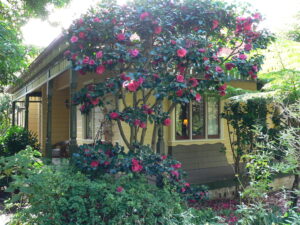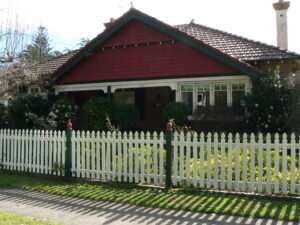Malton Road North (Odd numbered) Side

5 This may be the oldest house in Malton Road. The house is listed on the Hornsby Shire Council Heritage Register which comprises Schedule 5 (Environmental Heritage) of the Hornsby Local Environment Plan 2013.
7, Overleigh and at one stage Lynwood, was designed by the son, Charles Nixon, as a family investment property. As his parents aged, this was the final home in Beecroft for William Mark and Ada Nixon. It is English cottage style with the front verandahs originally being open. The dormer windows are later additions. This was the address of D Luxford for membership of the Civic Trust from 1983 to 2008.

11 – Kunamore, originally Lynwood, was built in 1909 to the design of William Mark Nixon and as the family home. In style this home is unique and very interesting with its double gable, awnings over the windows, slate roof and diamond-paned windows. The Cape Honeysuckle (tecoma capensisi) hedge extends across Overleigh as well as a sign of the once joint ownership. This was the Nixon’s second smaller home after the majority of the family left home and they downsized from the original home at Lynwood, 12 Malton Road. It presents a warmer, comfortable approach to living. The name Lynwood, came from the Nixon family home in Hawick, Scotland.
The home was later owned (from 1921 to 1991) by the Robertson-Swan family who were also significant community members. The current house name Kunawore means ‘nest of swans’ and dates from their ownership. Mrs Robertson-Swan had a major collection of tea pots and was on the committee of organisations including the Dickens Society, Red Cross and the Tree Lovers Civic League. She was a major fund raiser for local charitable causes. Charles Robertson-Swan supported his wife’s activities and was (for a short period) a local leader of the New Guard and for a longer period was actively involved in local cricket, tennis and bowls. Their son Raoul tragically died as a young man from an infection and there is a memorial seat in his memory on Beecroft Road in front of St Johns. Their daughter, Una, entered nursing, married a New Zealander but returned to live here following the death of her parents and a long career working for the War Widows Guild. She maintained the tradition of her parents in community service.
Miss Caddy (before she relocated to the Angican Retirement Villages, Castle Hill, lived in a flat provided by the Robertson Swans.
A poem was written about the garden at Kunawore:
The Sisters
Together, in a garden that I know,
Stand two young gum trees – tall and straight and slight;
While draped about their slender limbs of snow
Are two Wistaria vines – one mauve one white.
Like scented ringlets, tossed upon the breeze,
Their fragrant blossoms sway in careless grace,
Lending an added beauty to the trees,
Casting a sweet aroma o’er the place.
Like sisters, stand these saplings, side by side,
All decked for dancing neath the moon tonight –
Or, maybe, one’s a bridesmaid, one a bride –
The one in mauve – the other, veiled in white!
With single locks and arms that intertwine,
They seem to stoop and whisper secrets sweet;
While soft winds murmur o’er each branch and vine,
And perfumed petals flutter to our feet [1].
This was the address of Una Boyce (nee Robertson Swan) for membership in 1989 and for D Durham for membership of the Civic Trust in 2006 to 2008.
The house and garden are listed on the Hornsby Shire Council Heritage Register which comprises Schedule 5 (Environmental Heritage) of the Hornsby Local Environment Plan 2013.
[1] Myra M Campbell, Thornleigh, early 1930s.
15, now Ellswood formerly Bimbadeen has had early alterations enclosing a side verandah. As Elmswood College it was one of Beecroft’s dame schools between 1910 and 1913. Like the schools of Misses Long and Ogden, or those of Ravensworth and Arden these were commenced by ladies to provide a limited curriculum for boys and girls in the primary years and thereafter just girls. Other schools, like Beecroft Grammar, catered for boys. Conducting a school was (with nursing) one of the few options available for an educated woman who needed, or wanted, to support herself. This school was conducted by a widow, Mrs Mary Ann Boylson. Her late husband James had been a miller in Bathurst. Two of her three daughters, May and Marcella, worked with her. Her excellent scholastic results were published in the local paper. A garden fete was held in 1912 in aid of the Children’s Hospital – then in Camperdown. In June 1913, Mrs Boylson (aged 59 years) caught the train from the City late one afternoon and on alighting she started to walk across the level crossing as was the habit of local residents. Apparently she did not hear the train travelling south (the train to the north having just pulled out) and she was killed instantly when hit. Mrs Boylson’s son successfully claimed damages on behalf of his sisters in the sum of 750 pounds. The Railway appealed claimed contributory negligence and Mr Joseph Carlos appeared for the Estate. The Railway lost. During the trial her son stated that his mother died leaving no property. The school closed shortly thereafter and May and Marcella faded from the Beecroft scene.
This was the address of P Titterton for membership of the Civic Trust between 1994 to 2007.

17, Eureka
was built around 1915 and shows some Californian bungalow influence in its large front gable end with timber shingles.
This was the address of Sebastian Trouncer for membership of the Civic Trust between 1994 to 2008.
The house is listed on the Hornsby Shire Council Heritage Register which comprises Schedule 5 (Environmental Heritage) of the Hornsby Local Environment Plan 2013.
19, Atworthy. The house was built in 1905 in Federation cottage style. It was bought in 1993 by Ian and Annette Payne who sold it in 2015. They gave the name to the house, calling it after a farm owned by Mr Payne’s father at The Rock, near Wagga Wagga [1].
[1] Northern District Times, 19 August 2015p. 2
21 was probably built after 1910. The house shows the formality of the symmetrical Edwardian style with some Federation influence. Only one sidelight at the front door breaks the symmetry and a rare brass letter slit is in the front door. Note the hood over the western window. There are contrasting brick quoin on the entrance porch.
27, Cloonycarn [1]. This land was originally purchased in 1891 by Edward Tysoe Lea of Granville. He sold it in 1892 to Joseph Horne who sold it in 1909 to Winifred Carlos the wife of Joseph Carlos a barrister with chambers in Elizabeth Street Sydney. They proceeded to build this house in 1910. Mrs Carlos was a noted golfer and was a finalist in the 1907 Beecroft Golf Club competition.
A most attractive feature is the corner bay window repeated in the bay of the verandah. The brick and roughcast walls are complemented by fine leadlight windows in the bay, the front door and surrounds. The bay windows have the same Art Nouveau red rose design pattern. The present garden adds greatly to the vista.
The Carlos wedding in St Marys Cathedral, Sydney, was described “as a union of gentleness, grace and brightness with talent, honesty and true Irish big heartedness.” Joseph arrived in Sydney in 1890 from Ireland where he had topped the intermediate exam for the whole of Ireland notwithstanding that he did the exam from a stretcher. He went on to gain First Class Honours in Arts from the Royal University, Dublin. In Sydney he was called to the bar in 1895 and was a lecturer in Classics at St Johns College, University of Sydney, for 20 years. He was a barrister with chambers in Elizabeth Street, Sydney and successfully acted for the Boylson family in their negligence claim against the Railways for the death of their mother. He was appointed one of the Industrial Commissioners for wages in the clothing industry. His health continued to be poor and he spent three months each summer with his family in Leura. Winifred was a keen golfer and was one of the finalists in the local golf club competition of 1907. Joseph was closely involved with the Recruiting Association for Hornsby – Beecroft between 1912 and 1915 and made the presentation to local men being sent off as part of the Australian Imperial Forces in March 1916 when he was described as ‘one of the most eloquent speakers on the Northern line.’ In August of that same year they moved to a home in Strathfield and Joseph died in 1917. Amongst those attending his funeral were Messrs Frank Boylson and William Chorley. This house was retained and leased until 1923 when it was sold. Winifred died in 1933. It was purchased by Edward Wailes. His family retained the home until 1975.
The house is listed on the Hornsby Shire Council Heritage Register which comprises Schedule 5 (Environmental Heritage) of the Hornsby Local Environment Plan 2013.
[1] H Barker Houses of Hornsby Shire Vol 2 (Hornsby, 1998) pp 38-39
31A, Notrella.
This was probably built in the late 1920s. It is in bungalow style with a very good front porch and interesting curved brackets on the verandah. The formal garden is in keeping with the house.
The house is listed on the Hornsby Shire Council Heritage Register which comprises Schedule 5 (Environmental Heritage) of the Hornsby Local Environment Plan 2013.
35. This house was built in 1916 for Richmond and Sarah Harriet Swete. They had two maiden daughters (Dorothy Marie (born 1893) and Marjorie Carew (born 1890). The daughters sold the house in 1965 to Mr & Mrs J L Hilliard who remained until sale to the present owners in 1998. The Hilliards were important in the music life of Beecroft for which see elsewhere on this website.
37. The house is listed on the Hornsby Shire Council Heritage Register which comprises Schedule 5 (Environmental Heritage) of the Hornsby Local Environment Plan 2013.
47 was built around 1910.
49 The house is listed on the Hornsby Shire Council Heritage Register which comprises Schedule 5 (Environmental Heritage) of the Hornsby Local Environment Plan 2013.
57 Malton Road – corner Timbertop Way.
Portion 698 of the sale of the Field of Mars Common, was, like so many other portions initially sold to Robert Thomas Carter a land agent of Sydney. He purchased this portion on 20 June 1891. For the sale of the Commons see elsewhere on this website. On 1 March 1894 he sold this land to Charles James Cook a builder of Strathfield. Mr Cook subdivided the portion into 6 (calling the subdivision the Ellesmere Estate) and his mortgagee in possession sold the middle one on 6 November 1902 to Jessie May Marsh. She in turn sold in October 1905 to Henry Luttman Ellis a civil servant of Beecroft. He in turn sold it to Dewdney Ellis a traveller but also of Beecroft. Upon the death of the second Mr Ellis in 1952 part of the middle lot was sold to Alexander Hamilton Campbell and the eastern part (being the corner of modern day Timbertop Way but then forming part of Clarke Road) to Robert Wilkinson the younger a chemist initially working with Colonial Sugar Refining. The remainder of the land was transferred to the widow of the second Mr Ellis – Isabella Margaret Ellis.
Robert Wilkinson subdivided his land and the corner block to Timbertop Way was sold in September 1955 to Donald Oscar Pearson and his wife Shirley Elizabeth Pearson. Upon their deaths the land was sold in 1993. Upon the death of that owner in 2016 the land was sold in 2017.
Wilkinson further subdivided the remaining land on this site in 1988.
This was the address of H Dryburgh for membership of the Civic Trust between 1993 and 2008.
